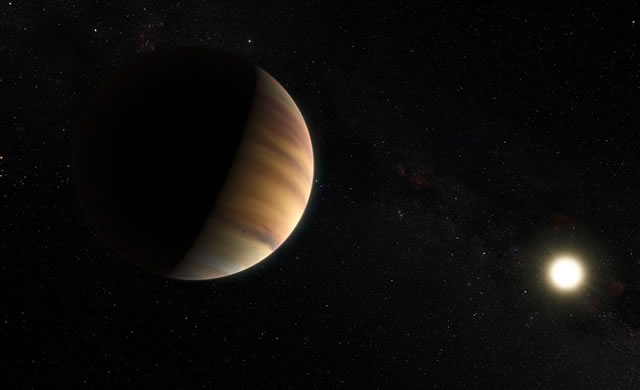
Alcuni astronomi, usando la macchina rintraccia-pianeti HARPS all’Osservatorio dell’ESO a La Silla in Cile hanno rilevato per la prima volta in modo diretto lo spettro di luce visibile riflessa da un esopianeta. Queste osservazioni hanno anche svelato nuove proprietà di questo oggetto famoso, il primo esopianeta mai scoperto intorno a una stella normale: 51 Pegasi b. Il risultato promette un brillante futuro a questa tecnica, in particolare con l’avvento degli strumenti di nuova generazione, come EXPRESSO, sul VLT, e dei futuri telescopi come l’E-ELT.
L’esopianeta 51 Pegasi b si trova a circa 50 anni luce dalla Terra nella costellazione di Pegaso. È stato scoperto nel 1995 e verrà sempre ricordato come il primo pianeta estrasolare confermato in orbita intorno a una stella normale come il Sole. Viene anche considerato come il tipico “Giove caldo” – una classe di pianeti extrasolari ormai ritenuta comune, simile in dimensione e massa a Giove, ma con un’orbita molto più vicina alla stella madre. Dal momento della storica scoperta sono stati confermati più di 1900 esopianeti in 1200 sistemi planetari, ma, nel ventesimo anniversario della scoperta, 51 Pegasi b torna ancora in pista per mostrare un nuovo progresso nello studio degli esopianeti. L’equipe che ha fatto questa misura è guidato da Jorge Martins dell’Istituto de Astrofísica e Ciências do Espaço (IA) e dell’Universidade do Porto, Portogallo, al momento studente di Dottorato presso l’ESO in Cile. Hanno usato lo strumento HARPS installato sul telescopio da 3,6 metri all’Osservatorio di La Silla in Cile. Attualmente il metodo usato più diffusamente per esaminare l’aftmosfera dell’esopianeta è di osservare lo spettro della stella madre filtrato attraverso l’atmosfera del pianeta durante il transito – una tecnica nota come spettroscopia in trasmissione. Un approccio alternativo è quello di osservare il sistema quando la stella passa di fronte al pianeta, cosa che fornisce soprattutto informazioni sulla temperatura dell’esopianeta. La nuova tecnica non richiede un transito planetario e perciò può potenzialmente essere usata per studiare molti più esopianeti; permette di rilevare direttamente lo spettro del pianeta in luce visibile, il che significa che si possono dedurre le diverse caratteristiche del pianeta inaccessibili con altre tecniche. Lo spettro della stella madre viene usato come modello per la ricerca di una impronta di luce simile che dovrebbe essere riflessa dal pianeta durante l’orbita. Questo è un compito estremamente difficile poichè i pianeti sono veramente deboli rispetto alle abbaglianti stelle madre. Il segnale proveniente dal pianeta viene anche sommerso facilmente da altri effetti molto piccoli e da varie sorgenti di rumore. Di fronte a tali difficoltà, il successo della tecnica applicata ai dati di HARPS raccolti su 51 Pegasi b risulta di grande valore.
Fonte/Leggi tutto → ESO.org
Astronomers using the HARPS planet-hunting machine at ESO’s La Silla Observatory in Chile have made the first-ever direct detection of the spectrum of visible light reflected off an exoplanet. These observations also revealed new properties of this famous object, the first exoplanet ever discovered around a normal star: 51 Pegasi b. The result promises an exciting future for this technique, particularly with the advent of next generation instruments, such as ESPRESSO, on the VLT, and future telescopes, such as the E-ELT.
The exoplanet 51 Pegasi b lies some 50 light-years from Earth in the constellation of Pegasus. It was discovered in 1995 and will forever be remembered as the first confirmed exoplanet to be found orbiting an ordinary star like the Sun. It is also regarded as the archetypal hot Jupiter — a class of planets now known to be relatively commonplace, which are similar in size and mass to Jupiter, but orbit much closer to their parent stars. Since that landmark discovery, more than 1900 exoplanets in 1200 planetary systems have been confirmed, but, in the year of the twentieth anniversary of its discovery, 51 Pegasi b returns to the ring once more to provide another advance in exoplanet studies. The team that made this new detection was led by Jorge Martins from the Instituto de Astrofísica e Ciências do Espaço (IA) and the Universidade do Porto, Portugal, who is currently a PhD student at ESO in Chile. They used the HARPS instrument on the ESO 3.6-metre telescope at the La Silla Observatory in Chile. Currently, the most widely used method to examine an exoplanet’s atmosphere is to observe the host star’s spectrum as it is filtered through the planet’s atmosphere during transit — a technique known as transmission spectroscopy. An alternative approach is to observe the system when the star passes in front of the planet, which primarily provides information about the exoplanet’s temperature. The new technique does not depend on finding a planetary transit, and so can potentially be used to study many more exoplanets. It allows the planetary reflected light spectrum to be directly detected in visible light, which means that different characteristics of the planet that are inaccessible to other techniques can be inferred. The host star’s spectrum is used as a template to guide a search for a similar signature of light that is expected to be reflected off the planet as it describes its orbit. This is an exceedingly difficult task as planets are incredibly dim in comparison to their dazzling parent stars. The signal from the planet is also easily swamped by other tiny effects and sources of noise. In the face of such adversity, the success of the technique when applied to the HARPS data collected on 51 Pegasi b provides an extremely valuable proof of concept.
Source/Continue reading → ESO.org





















